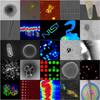The Molecular and BioPhotonics group research efforts focus on the development of the following:
- New photonic spectroscopic and imaging techniques for enhanced detection of molecules and biomolecules;
- Measurement standards for improving manufacturing quality and promoting acceptance of optical medical imaging technologies; and
- The application of photonics techniques to real world problems.
Projects and Programs
Publications
Software
Tools and Instruments
Awards
Patents
Contacts
Group Leader
-
(303) 497-7287







